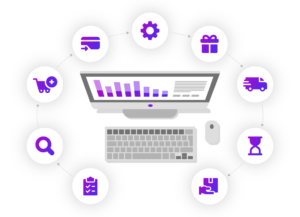Intellyx BrainBlog for Nacelle by Jason Bloomberg
In part one of this four-part series, I laid out the strengths and weaknesses of the GraphQL API query language for fulfilling queries. Then in part two, my colleague Jason English discussed how vital a canonical data model is for modern e-commerce offerings.
English pointed out that Nacelle’s Composable Commerce platform’s request-centric GraphQL-based data engine [transforms unstructured data into structured data] processes and normalizes commerce and content data into a data layer that can respond to complex multi-dimensional requests with one API; which makes it much faster and more efficient than managing multiple APIs for each service.
It might appear that GraphQL is a magic elixir, able to fix all that’s wrong with traditional monolithic e-commerce systems. GraphQL is powerful, to be sure – but there’s no magic here. Let’s delve deeper into Nacelle’s platform to gain a better understanding of how it works.
Data ingestion and normalization
The Nacelle platform can ingest data from multiple sources (since it’s system agnostic) – including best-of-breed systems for content, category, product, and inventory that are already in place in the e-commerce merchant’s infrastructure.
Nacelle uses pre-built connectors to access the APIs of these systems, while also ingesting data from data lakes and even flat files when necessary.
The result of all this ingestion – much of it in real-time – is a mishmash of different data formats. This diversity of data is why normalization is so essential.
Nacelle’s proprietary data orchestration layer handles this normalization by transforming incoming data into a single, consistent format. It then indexes that data to support rapid queries. Finally, it stores the data, making it available when and where the end-user wants it.
One of the primary benefits of normalization that differentiates Nacelle from other e-commerce solutions is the way it ensures that future changes to the data stack won’t require a complete refactor of existing connected systems.
In other words, it’s relatively simple to plug in additional data sources to enrich the e-commerce experience for end-users.
Data delivery for a flexible headless experience
Nacelle delivers both content and product data via a single GraphQL API. This API is where the power of GraphQL pays off for Nacelle customers, as the Nacelle platform automatically provides the information that any query is looking for – fast.
This data delivery supports multiple storefronts, apps and channels for a comprehensive e-commerce experience.
Supplemental to its GraphQL, Nacelle leverages software development kits (SDKs) and accelerators to support whatever off-the-shelf or customized front-end technology an e-commerce merchant wants to use.
Despite this diversity of modes of consumption, Nacelle’s normalization logic supports all of them. There’s no need to rewrite the normalization logic for each head or channel. Instead, Nacelle provides a consistent data structure across the board – for products, variants, content, inventory, and orders.
Furthermore, Nacelle propagates changes to all channels in real time. For example, if marketing launches a new campaign, Nacelle will transmit the specifics of that campaign to each head in a coordinated fashion.
Read the entire BrainBlog here.



